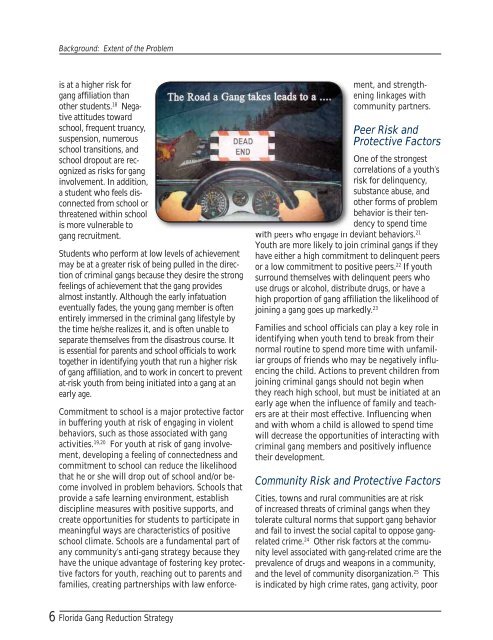Florida Gang Reduction Strategy 2008 - 2012
Florida Gang Reduction Strategy 2008 - 2012
Florida Gang Reduction Strategy 2008 - 2012
Create successful ePaper yourself
Turn your PDF publications into a flip-book with our unique Google optimized e-Paper software.
6<br />
Background: Extent of the Problem<br />
is at a higher risk for<br />
gang affiliation than<br />
other students. 18 Negative<br />
attitudes toward<br />
school, frequent truancy,<br />
suspension, numerous<br />
school transitions, and<br />
school dropout are recognized<br />
as risks for gang<br />
involvement. In addition,<br />
a student who feels disconnected<br />
from school or<br />
threatened within school<br />
is more vulnerable to<br />
gang recruitment.<br />
Students who perform at low levels of achievement<br />
may be at a greater risk of being pulled in the direction<br />
of criminal gangs because they desire the strong<br />
feelings of achievement that the gang provides<br />
almost instantly. Although the early infatuation<br />
eventually fades, the young gang member is often<br />
entirely immersed in the criminal gang lifestyle by<br />
the time he/she realizes it, and is often unable to<br />
separate themselves from the disastrous course. It<br />
is essential for parents and school officials to work<br />
together in identifying youth that run a higher risk<br />
of gang affiliation, and to work in concert to prevent<br />
at-risk youth from being initiated into a gang at an<br />
early age.<br />
Commitment to school is a major protective factor<br />
in buffering youth at risk of engaging in violent<br />
behaviors, such as those associated with gang<br />
activities. 19,20 For youth at risk of gang involvement,<br />
developing a feeling of connectedness and<br />
commitment to school can reduce the likelihood<br />
that he or she will drop out of school and/or become<br />
involved in problem behaviors. Schools that<br />
provide a safe learning environment, establish<br />
discipline measures with positive supports, and<br />
create opportunities for students to participate in<br />
meaningful ways are characteristics of positive<br />
school climate. Schools are a fundamental part of<br />
any community’s anti-gang strategy because they<br />
have the unique advantage of fostering key protective<br />
factors for youth, reaching out to parents and<br />
families, creating partnerships with law enforce-<br />
<strong>Florida</strong> <strong>Gang</strong> <strong>Reduction</strong> <strong>Strategy</strong><br />
ment, and strengthening<br />
linkages with<br />
community partners.<br />
Peer Risk and<br />
Protective Factors<br />
One of the strongest<br />
correlations of a youth’s<br />
risk for delinquency,<br />
substance abuse, and<br />
other forms of problem<br />
behavior is their tendency<br />
to spend time<br />
with peers who engage in deviant behaviors. 21<br />
Youth are more likely to join criminal gangs if they<br />
have either a high commitment to delinquent peers<br />
or a low commitment to positive peers. 22 If youth<br />
surround themselves with delinquent peers who<br />
use drugs or alcohol, distribute drugs, or have a<br />
high proportion of gang affiliation the likelihood of<br />
joining a gang goes up markedly. 23<br />
ith h i d<br />
Families and school officials can play a key role in<br />
identifying when youth tend to break from their<br />
normal routine to spend more time with unfamiliar<br />
groups of friends who may be negatively influencing<br />
the child. Actions to prevent children from<br />
joining criminal gangs should not begin when<br />
they reach high school, but must be initiated at an<br />
early age when the influence of family and teachers<br />
are at their most effective. Influencing when<br />
and with whom a child is allowed to spend time<br />
will decrease the opportunities of interacting with<br />
criminal gang members and positively influence<br />
their development.<br />
Community Risk and Protective Factors<br />
Cities, towns and rural communities are at risk<br />
of increased threats of criminal gangs when they<br />
tolerate cultural norms that support gang behavior<br />
and fail to invest the social capital to oppose gangrelated<br />
crime. 24 Other risk factors at the community<br />
level associated with gang-related crime are the<br />
prevalence of drugs and weapons in a community,<br />
and the level of community disorganization. 25 This<br />
is indicated by high crime rates, gang activity, poor


